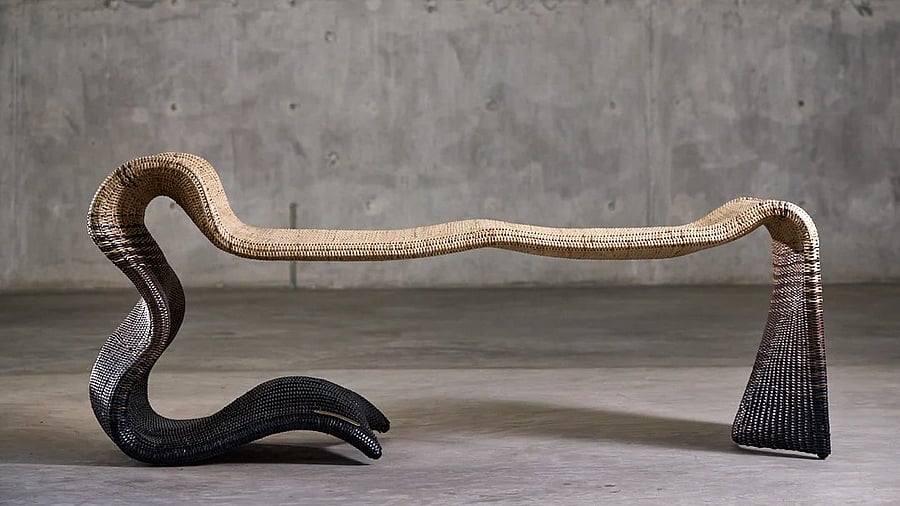
Bark bench.
In a world where planet-friendly design is the new standard, the works of Priyanka Narula let nature itself dictate the design, celebrating its forms and patterns. Each whimsical piece is made with age-old wickercraft, following a zero-waste approach, a nod to both the environment and heritage.
This philosophy comes to life in The Flowering Vines, a light installation that mimics a flower. The piece is modular and scalable. It can exist as a single petal or blossom, or be designed into a larger, interconnected composition, symbolising nature’s growth patterns. Its modular design makes it feel responsive to the space it lights up. Just as a flower unfolds in repeating petals and a plant grows in stages, the installation follows this natural flow, its light spilling across the space as softly as sunlight on petals.
This natural flow carries into the Pagdandi Wall Unit, where curves and twists create the feel of wandering away, offering a quiet retreat from our busy lives. Picture following a winding path through a forest; the design reflects this movement. Its meandering forms are inspired by the way rivers flow and forests wind, while the ledges and surfaces become moments of pause, where one could sit, like finding a log along the path. The shelving areas resemble pockets of land formed by the river, creating pauses and rhythm as you move along. Just as the movement of a river or a forest path is never contained in a small area, it keeps going. Similarly, the meandering pathways of the design adapt to the space; they can be scaled up or down.
Hues of the horizon
The studio’s early work stayed in monochromes, letting craft and material take the spotlight. Over time, they began exploring colour, driven by a desire to connect with India’s rich heritage, where colour plays a key role. This pursuit led to the Dawn to Dusk lamp, their first wicker experiment with colour, capturing the sky’s changing light in layered hues. “My morning and evening walks were my go-to for peace on a busy day. We wanted the palette to evoke that same calm,” Priyanka shares.
While watching the sky, they noticed that sunrise and sunset are not made of one colour. They change gradually, and each stage creates a different feeling. The first samples used seven to eight colours like black, maroon, red, orange, yellow and a few neutral shades. When layered together, they looked like a landscape painting. Each section of the lamp is inspired by a different setting. The sunrise section uses pale and soft colours, the sunset section uses warm and intense colours. The desert evening section shifts to monochrome tones, reflecting the sun-baked colours of desert landscapes.
The language of trees
The Dawn to Dusk lamp offers a visual experience of the sky, while the Bark Bench invites touch as much as it draws the eye. It’s inspired by the simple act of finding a fallen tree and sitting on it. Its twisting form reflects how a tree grows and bends over time. Each curve and surface invites people to linger and feel the texture. The colours follow its lifecycle: the base is dark, almost black like fungus, and slowly lightens toward the top. The seating area stays muted and natural, while the top is dry and pale. Despite its twists, the bench is comfortable and ergonomic, showing how old-school craft and modern design can work together to create pieces that feel like artefacts yet serve everyday use.
Similar to the bench, the Bark Jhula uses bark-like textures and colours and creates a sense of pause within movement. While the bench invites a moment of rest during a walk, the Jhula (swing) gives that same feeling while you sway. Priyanka describes this piece as a sculpture in motion. The swing recalls childhood memories of swings in parks and homes. The idea was to evoke the same tactile joy of sitting on a classic tyre swing. “Its basic circular form keeps that DIY spirit, and when you sit on it, it holds its shape and feels secure,” she notes.
Traditionally, basketry belonged to kitchens and corners, holding fruits or laundry. In these works, it takes on a new identity. Each piece is treated as a body made of a skeleton and skin. The skin remains basketry, and the skeleton can be cane, board or metal. That small addition opens up new possibilities, allowing the craft to move from household objects to furniture and sculptural forms. This approach comes from a simple belief: a craft must grow to stay alive. If it stays fixed in its past, it fades quietly. By giving basketry new roles, these works keep their legacy evolving rather than being preserved and outdated.